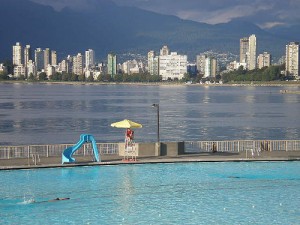 Summer activities with your children can be…well…different (read: difficult). A tenuous balance of organization and cursing — to yourself — under your breath. The perpetual list of items: sunblock (not baby oil), shovels, buckets, frisbees, a cooler with drinks (no beer), containers of snack-foods and fruit and a bit of change ($10) for some frozen treats. Towels and blankets and changes of clothing. Books for those who prefers to stay on shore. The list goes on — and that’s just for the kids.
Summer activities with your children can be…well…different (read: difficult). A tenuous balance of organization and cursing — to yourself — under your breath. The perpetual list of items: sunblock (not baby oil), shovels, buckets, frisbees, a cooler with drinks (no beer), containers of snack-foods and fruit and a bit of change ($10) for some frozen treats. Towels and blankets and changes of clothing. Books for those who prefers to stay on shore. The list goes on — and that’s just for the kids.
For yourself, perhaps a quick, self-conscious glance at your absent 6-pack abs of aluminum foil, and the consideration that you’d better put that silly zinc strip on your nose. Pull on the floppy Tilley hat and kick on your mismatched flip-flops. But please be intuitive enough to leave the white socks in their drawer.
And for the love of Pete this is not the time to dust off your old Chip and Pepper tank top from 1989.
Alright, I’m pushing it — I know. We can be fit, healthy parents with reasonable fashion-sense. My point is heading to the beach or water-park or outdoor pool requires a certain clutter of preparation. A clutter that often requires self-sacrifice, but always includes the parental instinct for your child’s general safety.
Water safety is a big one, in my opinion. With crowds of kids and general excitement, things happen. And it’s easy to miss — just ask your local lifeguard.
But what may surprise some is how drowning does not actually look like the drowning we see in movies. No flailing of limbs or loud cries for help.
Mario Vittone, a blogger with 19 years experience in the U.S. Navy and Coast Guard, writes about looking for the symptoms of a drowning child. A worthwhile read for any concerned father, Mario lists several key behaviors to be on the look out for:
- Head low in the water, mouth at water level
- Head tilted back with mouth open
- Eyes glassy and empty, unable to focus
- Eyes closed
- Hair over forehead or eyes
- Not using legs – Vertical
- Hyperventilating or gasping
- Trying to swim in a particular direction but not making headway
- Trying to roll over on the back
- Ladder climb, rarely out of the water.
What puts this into an even greater context is Mario’s 2006 article about How to Recognize the Instinctive Drowning Response (On Scene Magazine, 2006 p. 16 pdf). A person has a built-in response to drowning, and it is not the messy, loud theatrics you see in film.
- Except in rare circumstances, drowning people are physiologically unable to call out for help. The respiratory system was designed for breathing. Speech is the secondary or overlaid function. Breathing must be fulfilled, before speech occurs.
- Drowning people’s mouths alternately sink below and reappear above the surface of the water. The mouths of drowning people are not above the surface of the water long enough for them to exhale, inhale, and call out for help. When the drowning people’s mouths are above the surface, they exhale and inhale quickly as their mouths start to sink below the surface of the water.
- Drowning people cannot wave for help. Nature instinctively forces them to extend their arms laterally and press down on the water’s surface. Pressing down on the surface of the water, permits drowning people to leverage their bodies so they can lift their mouths out of the water to breathe.
- Throughout the Instinctive Drowning Response, drowning people cannot voluntarily control their arm movements. Physiologically, drowning people who are struggling on the surface of the water cannot stop drowning and perform voluntary movements such as waving for help, moving toward a rescuer, or reaching out for a piece of rescue equipment.
- From beginning to end of the Instinctive Drowning Response people’s bodies remain upright in the water, with no evidence of a supporting kick. Unless rescued by a trained lifeguard, these drowning people can only struggle on the surface of the water from 20 to 60 seconds before submersion occurs.
Hopefully some useful information for the hasty, brilliant days of summer.
